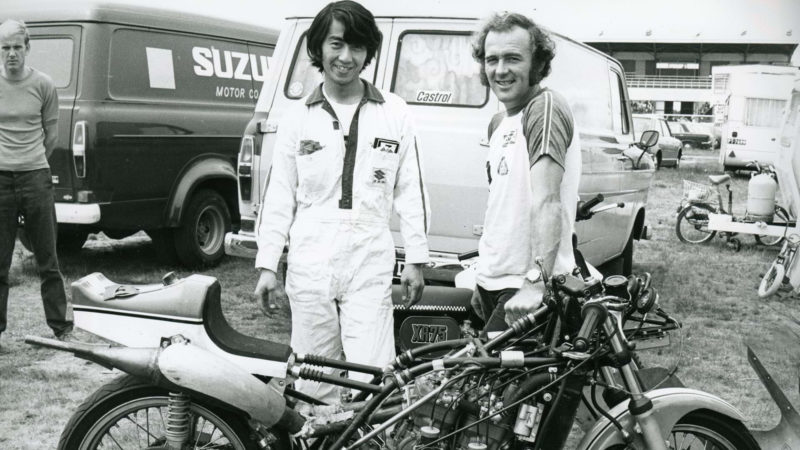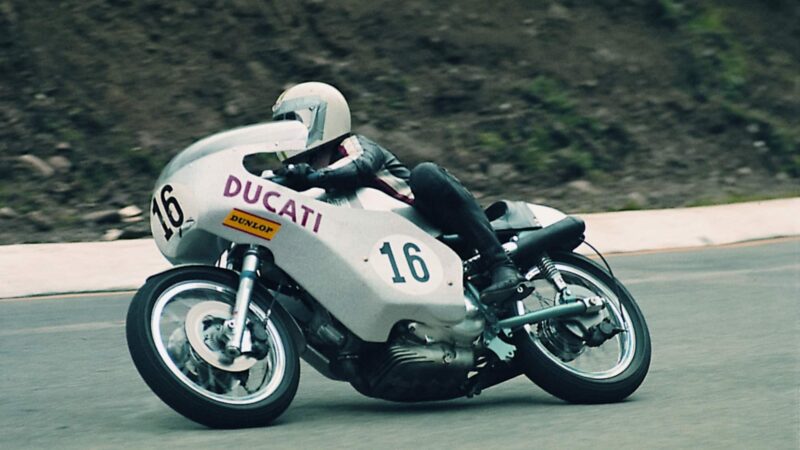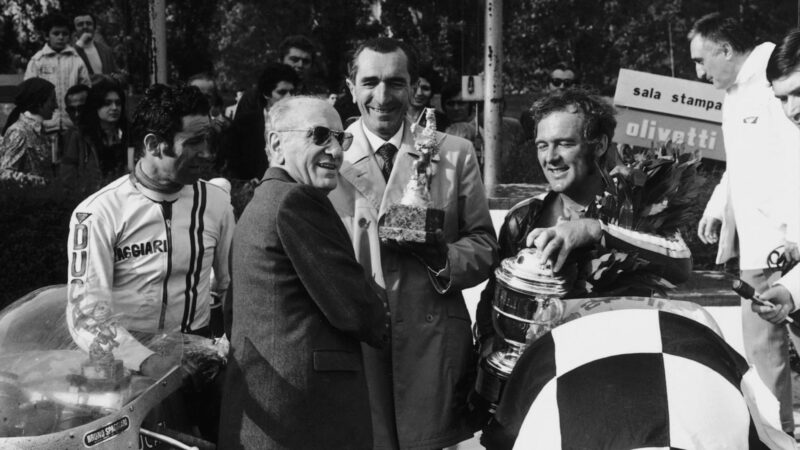Paul Smart: 1943-2021

Paul Smart, who has died following a road accident, rode through one of the greatest crossroads in motorcycle-racing history: from British dominance to Japanese dominance, from four-stroke to two-stroke and from treaded tyres to slick tyres.
All these seismic changes were happening at the same time and Smart was right there in the middle of it, successfully navigating his way through what must have been one of the most confusing periods in the sport’s history.
Smart rode for the Triumph, Kawasaki, Ducati and Suzuki factories and was also in middle of it all in the paddock. Married to Barry Sheene’s sister Maggie, the Sheene and Smart caravans were a hub of paddock social interaction – good times happening all the time.
Smart is most famous for his victory in the 1972 Imola 200 – the Daytona of Europe – aboard Ducati’s very first big v-twin, the 750SS. This was the success that put Ducati on the road to where it is now. At that time the company was under the control of the Italian government, because it had been teetering on the brink of bankruptcy for several years.
If it was that Imola 200 success that saved Ducati, would it be right to say that Smart’s riding talent saved the venerable Italian marque from extinction? Not quite, because Ducati took a one-two in the race, with regular factory rider Bruno Spaggiari chasing Smart over the finish line.
Smart made his name in the 1960s, riding British-built 250s, backed by former Brooklands star Charles Mortimer, father of 1970s GP winner Chas.
In 1970 he raced a factory Trident 750cc triple for the Triumph factory but the British industry was already falling apart. Smart saw the collapse from up close.
“Doug Hele [legendary engineer] would design new engines which would go before the Triumph board of directors – these funny old boys asleep in their soup – and they’d just reject everything,” Smart recalled. “Oh, they’d say, we’re still selling lots of 650s, so there’s no point investing in a new production line. If Doug had been allowed to do what he wanted, and there’d been some investment, the British industry would never have stopped,”
When Smart lost his Triumph ride he decided to ply his trade where he might make a decent living, so he moved to the USA, where he rode for the Hansen Kawasaki factory team. Climbing off a plodding Triumph onto an evil-handling, tyre-shredding H2-R two-stroke 750 was a big shock for Smart and anyone else who made the switch.
And yet this was was time to adapt or give up. Every top rider of the early 19070s realised that if they wanted to win races they had to go two-stroke, never mind the fact that they lived constantly in fear of engine seizures, tyre blowouts and bowel-loosening top-speed tank-slappers.
“The two-strokes were animals, absolute animals,” said Smart many years later. “The handling was appalling and the reliability was abysmal. They used to shed bits and overheat – everything was on the ragged edge.

Paul Smart on his way to making history for Ducati at Imola in 1972, but he enjoyed more success racing for Suzuki and Kawasaki in the USA
“The huge Achilles heel riding those bloody things was that the tyres couldn’t stand the huge increase in speed. When we got to the speed bowls, which is what the Americans used for a lot of races, the bikes were doing 175 miles an hour and the tyres would do two laps and fly to pieces. Suddenly you’d get this tremendous vibration and ‘bang!’ the tyre exploded. It drove you round the bend; you dreaded your next race.”
Nevertheless Smart won the H2-R’s first big win in 1972. In April of that year he was racing at Road Atlanta when Maggie got a call at their home in California. On the other end of the line was Ducati general manager Fredmano Spairani, looking for someone to ride his new 750 at the big Imola race.
Smart hadn’t topped Spairani’s list. First he tried engaging the services of Finnish genius Jarno Saarinen, who was too busy with GP duties. Then he tried 21-year-old Sheene, but the up-and-coming Brit wasn’t interested either, firstly because he didn’t think the Ducati would be up to much and secondly because the company wouldn’t agree to his substantial financial demands.
Hence the call to Smart, 6000 miles away. “Would Mr Smart be interested in riding our new motorcycle at Imola?”, asked Spairani. “Yes,” said Mrs Smart.
However, when Maggie called Paul at Road Atlanta he wasn’t happy at all. The last thing he wanted was to leave his lucrative job in the States and ride an old-fashioned four-stroke. But he did and the rest is history.
At Imola many people commented on Smart’s hang-off riding technique, but he had been riding like that for a while, perhaps to help drag those wayward two-strokes around corners in the US, where someone commented that he went “around corners with only his toenails left on the bike”.
In 1973 Smart was signed by US Suzuki to rides its XR11, another evil-handling, tyre-shredding 750cc two-stroke.
These creations, built around the new generation of large-capacity two-stroke road bikes coming out of Japan, guzzled fuel like nothing else. The XR11 did around 13mpg – so mid-race pit stops were essential, via dodgy dump tank systems, which threatened to engulf the whole crew in flames if anything went slightly wrong.
“The fuel stops were horrendous, they covered me in petrol a few times,” Smart remembered.

Smart (right) and runner-up Spaggiari at Imola in 1972. Fabio Taglioni, the engineer who put Ducati on the road to success, is centre, holding a trophy
Tyres, however, remained the biggest worry. Horsepower outputs had rocketed almost overnight, from 85-horsepower four-strokes to 100-horsepower two-strokes, so the tyre companies were scrambling to catch up, fully aware that someone would die if they didn’t.
“Dunlop worked day and night,” said Smart. “Then I went to the Dallas race in April ’73 and they said they’d sorted the problem. They took me into a darkened room and there it was – a tyre with no f****** tread on it. They said ‘you’ve got to believe us, this will work’.”
Dunlop wasn’t wrong. “I just cleared off and won.”
Smart and others were paid well for risking their lives and growing old early. That Dallas victory sent Smart home with a pay cheque for $10,000 – enough to buy half a house in Los Angeles. After that he made a habit of scooping the biggest prizes.
Smart twice qualified on pole for the Daytona 200 but was always let down by those fickle two-strokes on the Floridian banking. He also rode for the British team in the Transatlantic series on several occasions.
He also played an important role, alongside brother-in-law and now team-mate Sheene, in developing and debugging Suzuki’s seminal RG500, the machine that would entirely change the face of premier-class grands prix.
The RG500 made its GP debut at Clermont-Ferrand in April 1974, where Smart started alongside Sheene. He only lasted a few laps, because he had broken an arm nine days earlier.
Back in Europe following his US sojourn his luck had ran out. A few months after the French GP he crashed and broke both femurs at the Mallory Park Race of the Year. And the following year he rebroke a femur.
Smart retired to concentrate on his burgeoning motorcycle dealerships in his home county of Kent.
In recent decades he became something of a mascot for Ducati, because he was the man that kickstarted the company’s journey to superbike dominance. In 2006 Ducati launched the limited-edition Paul Smart 1000 LE, a modern recreation of the bike he rode to victory at Imola.
Paul Smart was always one of the friendliest, humblest, funniest people you could meet in paddocks around the world. He is survived by Maggie, son Scott and daughter Paula.
Motor Sport would like to send their condolences to Smart’s family, friends and loved ones.

